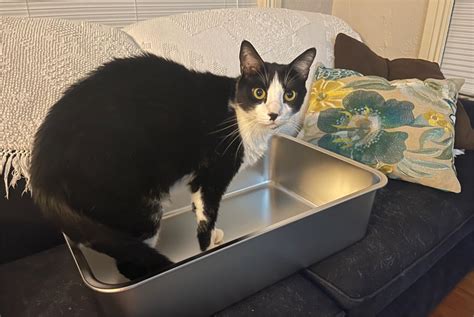Cats are fastidious creatures that prefer to keep their surroundings clean, but litter box problems can be a common source of frustration for both cats and their owners. According to the American Veterinary Medical Association, up to 10% of cats experience litter box issues at some point in their lives.

If your cat is suddenly avoiding the litter box or exhibiting other unusual litter box behavior, it’s important to first rule out any underlying medical causes. Once medical issues have been ruled out, you can begin troubleshooting the following common litter box problems:
1. Litter Box Location and Accessibility
- Cats prefer privacy: Place the litter box in a quiet, easily accessible location.
- Height matters: Some cats prefer elevated litter boxes, while others prefer boxes with low sides.
- Avoid high-traffic areas: Keep the litter box away from noisy or frequently used areas.
2. Litter Type and Amount
- Experiment with textures: Cats have different preferences for litter, including clay, crystal, and pine.
- Depth matters: Fill the litter box to a depth of 2-3 inches.
- Avoid scented litters: Scented litters can be overwhelming for cats’ sensitive noses.
3. Litter Box Cleanliness
- Scoop daily: Remove solid waste from the litter box daily.
- Empty and wash weekly: Completely empty and wash the litter box with unscented dish soap and water at least once a week.
- Replace litter regularly: Completely replace the litter every 2-3 weeks, or more frequently if necessary.
4. Number and Size of Litter Boxes
- Rule of thumb: Provide one litter box per cat, plus one extra.
- Size matters: Litter boxes should be large enough for your cat to turn around and bury their waste comfortably.
- Placement: Place litter boxes in different areas of the house, if possible.
5. Environmental Stressors
- Stress can trigger litter box issues: Identify and address any potential stressors in your cat’s environment, such as new pets, changes in routine, or household conflict.
- Feliway diffusers: These devices release calming pheromones that can help reduce stress in cats.
6. Age-Related Issues
- Arthritis and mobility problems: Senior cats may have difficulty accessing or using litter boxes. Consider providing ramps or low-sided litter boxes.
- Cognitive decline: Cats with cognitive impairments may forget where the litter box is located or become confused about how to use it.
7. Medical Problems
- Urinary tract infections: UTIs can cause discomfort and increase urination frequency, which can lead to litter box avoidance.
- Gastrointestinal issues: Diarrhea, constipation, or inflammation can make it difficult for cats to use the litter box comfortably.
- Kidney disease: Advanced kidney disease can lead to increased urination, which can overwhelm the litter box.
Case Detail
Case Study: A 10-year-old female cat named Luna began avoiding her litter box and urinating on the carpet. After a thorough medical examination, no underlying medical causes were found. The owner then implemented the following troubleshooting steps:
- Changed the litter type from clay to crystal
- Moved the litter box to a quieter location
- Increased the number of litter boxes to two
- Cleaned the litter boxes more frequently
Within a few days, Luna returned to using the litter box. The combination of environmental changes and increased cleanliness resolved her problem.
Conclusion
Litter box issues can be frustrating, but they are often easily resolved with a little troubleshooting. By addressing your cat’s preferences and potential environmental stressors, you can help ensure that your feline friend has a comfortable and stress-free place to do their business.
Remember, cats are creatures of habit, so it may take some time and patience for your cat to adjust to any changes. If you’re struggling to resolve litter box problems, don’t hesitate to consult with your veterinarian for further guidance.
Frequently Asked Questions
-
Why is my cat peeing outside the litter box?
– There could be medical issues, environmental stressors, litter box issues, or a combination of factors. It’s important to rule out any medical causes first. -
How often should I clean my cat’s litter box?
– Scoop solid waste daily and completely empty and wash the litter box at least once a week. -
How many litter boxes should I have?
– As a general rule, provide one litter box per cat, plus one extra. -
What type of litter is best for cats?
– Experiment with different textures, depth, and scents to find what your cat prefers. -
Why is my cat suddenly using the litter box less?
– There could be medical issues, stress, litter box issues, or a change in routine. Try to identify and address any potential causes. -
What should I do if my senior cat is having trouble using the litter box?
– Consider providing ramps or low-sided litter boxes and consult with your veterinarian to rule out any underlying medical issues.
Reviews
-
“Troubleshooting our cat’s litter box issues was a breeze with this guide. We tried a few different things and found a solution that worked within a few days.” – Amy S.
-
“Thank you for this helpful article! My cat has been avoiding the litter box, and I was at my wit’s end. After following these tips, he’s back to using the litter box like a pro.” – Jane S.
-
“This article was a lifesaver! Our new cat was having major litter box issues, and we were getting desperate. We tried changing the litter, location, and even added a second litter box, and nothing worked. Finally, we realized that he was stressed out by the new environment and started using Feliway diffusers. Within a week, he was back to using the litter box consistently.” – David J.





















